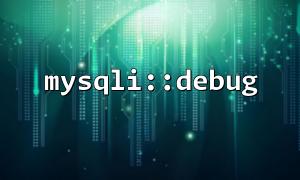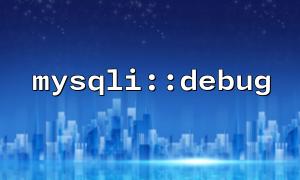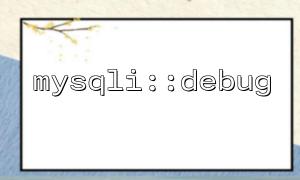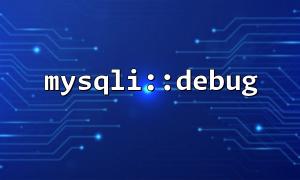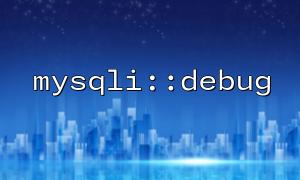When developing PHP applications, intermittent database connection errors can affect the normal operation of the program. Generally, these errors occur due to database server unavailability or configuration issues. However, in some cases, these errors may not be entirely caused by the server but may result from issues in the code or other subtle factors. In such cases, mysqli::debug can help developers troubleshoot these errors.
This article will explain how to use the mysqli::debug method to troubleshoot intermittent database connection errors and obtain detailed debugging information to better resolve the issues.
mysqli::debug is a debugging feature provided by the MySQLi extension library, which outputs detailed information related to database connections and queries. Developers can use it to view database connection, query execution, and error information, helping them pinpoint database-related issues.
To use mysqli::debug, you need to ensure that the MySQLi extension is enabled in your PHP environment. Then, you can call the mysqli::debug method in your code to enable debugging output. Here's an example of how to use it:
<?php
// Enable debug mode
mysqli_report(MYSQLI_REPORT_ERROR | MYSQLI_REPORT_STRICT);
<p>// Create a database connection<br>
$mysqli = new mysqli('m66.net', 'username', 'password', 'database');</p>
<p>// Check if the connection is successful<br>
if ($mysqli->connect_error) {<br>
die("Connection failed: " . $mysqli->connect_error);<br>
}</p>
<p>// Enable debugging<br>
$mysqli->debug("enabled");<br>
?><br>
In real-world applications, intermittent database connection errors usually occur due to network issues, high database server load, or other subtle reasons. With mysqli::debug, you can view detailed debugging information for each database connection and query execution, which is crucial for diagnosing problems.
Enable mysqli::debug Debugging Information
Calling mysqli::debug("enabled") will enable debugging output, causing relevant information to be output for every database connection and query execution.
Check the Debugging Information
The debugging information usually includes the following:
Detailed information about the database connection
The execution status of the queries
Error messages returned by the database
With this information, you can determine whether the connection is stable, whether queries are executed correctly, and whether there are any timeouts or other errors.
View Database Connection Information
After enabling mysqli::debug, you can view detailed information related to the database connection in the logs, including server response times and connection status. This information can help you determine whether the database connection is experiencing issues during intermittent errors.
Suppose we encounter intermittent database connection failures in our application, we can follow these steps to debug:
<?php
// Enable debug mode
mysqli_report(MYSQLI_REPORT_ERROR | MYSQLI_REPORT_STRICT);
<p>$mysqli = new mysqli('m66.net', 'username', 'password', 'database');</p>
<p>// Enable debugging information output<br>
$mysqli->debug("enabled");</p>
<p>// Simulate a query operation<br>
$query = "SELECT * FROM users WHERE id = 1";<br>
$result = $mysqli->query($query);</p>
<p>if ($result === false) {<br>
echo "Query execution failed: " . $mysqli->error;<br>
} else {<br>
while ($row = $result->fetch_assoc()) {<br>
echo $row['username'] . "<br>";<br>
}<br>
}<br>
?><br>
By enabling debugging information, we can view detailed information about the database connection and query execution, helping us determine whether the issue is with the database connection. If the database fails to respond at certain times, the output from mysqli::debug can help further analyze the cause.
Network Issues
If database connections frequently fail, it might be due to network instability or server configuration issues. You can check the response time in the logs to determine whether network latency is causing the issue.
Database Server Overload
If the database server is overloaded, it may cause connection failures. You can see the response time when connecting in the mysqli::debug output. If the response time is long, it indicates high database load, and you may need to optimize database performance or increase server resources.
Configuration Issues
Check whether the database configuration (such as max connections, timeout settings, etc.) is reasonable. mysqli::debug can help confirm whether the issue is related to configuration settings causing connection failures.
By using mysqli::debug, you can easily enable debugging mode and obtain detailed information about database connections and queries. This is very effective for troubleshooting intermittent database connection errors, helping you quickly locate and resolve issues. Remember, debugging information is meant for development use only; ensure you disable debugging in a production environment to avoid exposing sensitive information.
Related Tags:
mysqli
